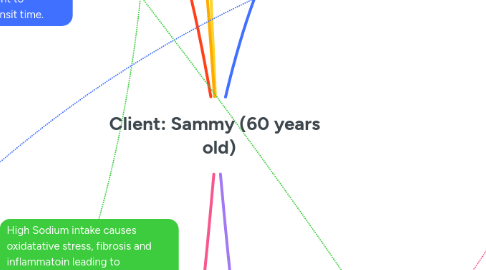
1. Immune
1.1. Facts/Inputs
1.1.1. Bleeding gum
1.1.2. Halitosis
1.1.3. Recent Abs
1.2. Underlying Cause/Theory
1.2.1. Systemic immune response
1.2.2. recent AB and gut dysbiosis - low SCFA - immune dysfunction
1.2.3. lack of precursors for immune function
1.2.4. 30 years of smoking, leads to methylation changes altering cytokine signalling (Lou et al)
2. CVS
2.1. Facts/Inputs
2.1.1. Red Flag - Untreated Hypertension stage II
2.1.2. Red Falg - Elevated heart rate (80 bpm) early sign of CVD
2.1.3. Obesity
2.2. Underlying Cause/Theory
2.2.1. Peridontitis
2.2.2. Obesity -
2.2.2.1. raises HR - RAAS system activation - elevates BP - elevated pulse indicated possible underlying CVD
2.2.2.2. increased free fatty acids - insulin resistance
2.2.3. Lifestyle (sedentary)
2.2.4. Systemic inflammation, endothelial tissue inflammation.
3. Physical Assessment
3.1. Vitals
3.1.1. Red Flag CVD: BP: 146/84
3.1.2. Pulse: 80 bpm
3.2. Anthropometrics
3.2.1. 95 kg
3.2.2. 1.75 m
3.2.3. BMI = 31
3.3. Signs
3.3.1. Whiteness on Tongue
3.3.2. Fingernail - brittle, cracked (tip), peel easily
3.3.3. Red gums
3.3.3.1. bleeding when brushing
4. Dietary Analysis (Appendix II)
4.1. Macro
4.1.1. Food Groups
4.1.1.1. Grains
4.1.1.1.1. 4.88 serves < 6 (Recommended - Aust Dietary Guidelines)
4.1.1.2. Fruit
4.1.1.2.1. 1.19 serves < 2
4.1.1.3. Vegetables
4.1.1.3.1. 5.41 serves < 5.5
4.1.1.4. Protein
4.1.1.4.1. 3.57 serves > 2.5
4.1.1.5. Dairy
4.1.1.5.1. 0.80 serves < 2.5
4.1.2. Fats
4.1.2.1. Monounsaturated - 54.7%
4.1.2.2. Polyunsaturated - 17.8%
4.1.2.3. Red Flag CVD - Saturated - 27.5%
4.1.3. Percentage Distribution
4.1.3.1. Carbohydrates - 40.1%
4.1.3.2. Red flag CVD - Fat - 37.1%
4.1.3.3. Protein - 17.7%
4.1.3.3.1. Protein consumption (uneven)
4.1.3.4. Other - 2.3%
4.1.3.5. Fibre 2.2%
4.1.3.6. Alcohol - 0.7%
4.2. Energy Requirements
4.2.1. Estimated Energy Requirement (EER)
4.2.1.1. 10,671 kJ
4.2.2. Basal Metabolic Rate (BMR)
4.2.2.1. 7,114 kJ
4.3. Micro
4.3.1. Adequate Intake
4.3.1.1. Water - 75%
4.3.1.2. Dietary fibre - 133%
4.3.1.3. Sodium - 702%
4.3.1.3.1. Suggested Dietary Target Maximum (SDTMax)
4.3.1.4. Alpha-linolenic (ALA) - 346%
4.3.1.5. Very Long Chain FA - 80%
4.3.1.5.1. Suggested Dietary Target Minimum (SDTMin)
4.3.2. Recommended Daily Intake (RDI)
4.3.2.1. Protein - 189%
4.3.2.2. Niacin eq. - 505%
4.3.2.3. Vitamin B6 - 141%
4.3.2.4. Total Vitamin A - 479%
4.3.2.4.1. Red flag: Range over 1000 mcg can result in acute toxicity ( consumed 4315 mcg in one day)
4.3.2.5. Calcium - 65%
4.3.2.6. Zinc - 79%
4.3.3. Estimated Average Requirement (EAR)
4.3.3.1. Calcium - 78%
4.3.3.2. Zinc - 92%
4.3.3.3. Total Vitamin A - 690%
5. Digestive System (GIT)
5.1. Facts/Inputs
5.1.1. Bad breath
5.1.2. Lack of appetite
5.1.3. Altered taste perception
5.1.3.1. Zinc
5.1.4. Heart burn/Reflux
5.1.4.1. Red Flag - risk of cardic pain confused/self-diagnosed as heart burn. .
5.1.5. White Coating on tongue
5.1.5.1. dehydration, oral bacteria - dysbiosis due to dental hygiene
5.1.6. Recently antibiotic ingestion
5.1.7. Salt craving
5.1.8. Bowel Movement - twice/week
5.1.8.1. BSC 1/2
5.1.9. poor digestion
5.1.10. sense of fullness with small intake
5.2. Underlying Cause/Theory
5.2.1. GORD
5.2.2. General Dyspepsia
5.2.3. Constipation
5.2.4. Gut Dysbiosis
5.2.5. Decreased HCL production
5.2.6. lack of nutrients and precursors for digestive function (zinc, protien)
5.2.7. Low LOS tone - lack of precursors for HCL, lack of stimulation for LOS - reflux + delayed gastric emptying + reduced stimulation of bile and pancreatic enzymes.
5.2.8. delayed gatric empyting and low HCL, bile and pancreatic enzymes - increased potental for pathogen and bacterial overgrowth.
5.2.9. Gastric emptying of food into small intestine = duodenal dysbiosis, hyperpermeability leading to systemic inflammation and ROS
5.2.10. decreased moltilty - frequently eating, bacterial overgrowth - constipation
5.2.11. Oral dysbiosis - intorductin of pathogens to entire GIT dysbiosis, inflammation, epethelial brush border destruction and immune system activation.
6. Holistic Analysis
6.1. Predisposing
6.1.1. Smoking (20/day > 30 yrs)
6.1.2. Maternal Fm Hx - Type II diabetes
6.1.3. Paternal Fm Hx - MI (died)
6.1.3.1. Red Flag - CVD
6.1.4. Brother Benign Prostatic Hyperplasia
6.1.5. Physical labour - 6 days for 40 yrs+
6.2. Excitatory
6.3. Sustaining
6.3.1. 'Quick-eze' - neutralises HCl
6.3.2. Sedentary/Back pain
6.3.3. stress
6.3.4. Does not floss teeth and brushes only once a day
